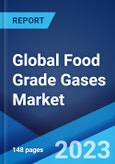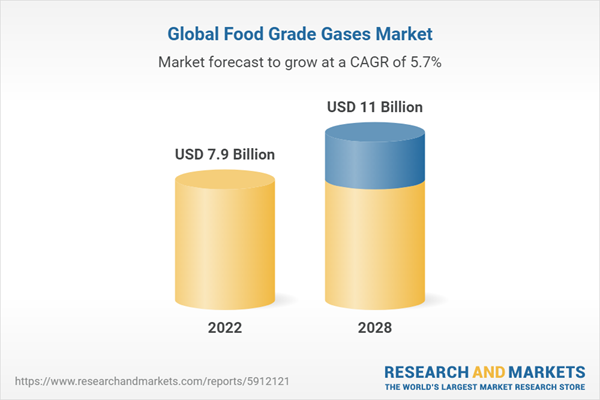The global food grade gases market size reached US$ 7.9 Billion in 2022. Looking forward, the market is expected to reach US$ 11.0 Billion by 2028, exhibiting a growth rate (CAGR) of 5.67% during 2022-2028.
Food grade gases are specialized gases used for packaging, preservation, freezing, and carbonation of food products. Some of the commonly used food grade gases include argon, hydrogen, carbon dioxide, nitrogen and oxygen. They are used for the preparation of food and beverages, such as bakery, dairy and meat products, fruits, vegetables, oil, sauces, dressings, condiments and carbonated drinks. They are utilized as an additive or processing aid during food preparation. These gases are passed through food products to reduce moisture and oxygen content and optimize them for preparation or storage. They are also used as propellants in aerosol dispensed food products, such as creams and cheeses, and to create microbubbles in desserts for improving texture and fluffiness.
Food grade gases are specialized gases used for packaging, preservation, freezing, and carbonation of food products. Some of the commonly used food grade gases include argon, hydrogen, carbon dioxide, nitrogen and oxygen. They are used for the preparation of food and beverages, such as bakery, dairy and meat products, fruits, vegetables, oil, sauces, dressings, condiments and carbonated drinks. They are utilized as an additive or processing aid during food preparation. These gases are passed through food products to reduce moisture and oxygen content and optimize them for preparation or storage. They are also used as propellants in aerosol dispensed food products, such as creams and cheeses, and to create microbubbles in desserts for improving texture and fluffiness.
Food Grade Gases Market Trends
Significant growth in the food and beverage industry is one of the key factors creating a positive outlook for the market. There is a rising demand for premium-quality meat and seafood products among health-conscious consumers, which is increasing the requirement for food grade gases. Moreover, the widespread adoption of modified air packaging (MAP) solutions is providing a thrust to the market growth. Food grade gases are used to retain the freshness of packaged food, especially organic fruits and vegetables and meat products, and enhancing the shelf-life of cheeses and pasta without using synthetic chemicals. In line with this, the increasing product utilization in hotels, cafes, quick serving restaurants (QSRs) and microbreweries are also contributing to the growth of the market. Other factors, including rising expenditure capacities of the consumers, along with the escalating consumption of packaged food products among the masses, are anticipated to drive the market toward growth.Key Market Segmentation
This research provides an analysis of the key trends in each sub-segment of the global food grade gases market report, along with forecasts at the global, regional and country level from 2023-2028. The report has categorized the market based on type, application and end user.Breakup by Type:
- Carbon Dioxide
- Nitrogen
- Oxygen
Breakup by Application:
- Freezing and Chilling
- Packaging and Carbonation
Breakup by End User:
- Beverages
- Meat and Seafood
- Convenience Food Products
Breakup by Region:
- North America
- United States
- Canada
- Asia-Pacific
- China
- Japan
- India
- South Korea
- Australia
- Indonesia
- Europe
- Germany
- France
- United Kingdom
- Italy
- Spain
- Russia
- Latin America
- Brazil
- Mexico
- Middle East and Africa
Competitive Landscape
The competitive landscape of the industry has also been examined along with the profiles of the key players being Air Liquide S.A., Air Products Inc., Air Water Inc., Coregas Pty Ltd (Wesfarmers Limited), Gulf Cryo, Linde plc, Massy Group Inc, SOL Spa, Taiyo Nippon Sanso Corporation (Mitsubishi Chemical Holdings Corporation), The Messer Group GmbH and Tyczka Polska Sp. z o.o.Key Questions Answered in This Report:
- How has the global food grade gases market performed so far and how will it perform in the coming years?
- What has been the impact of COVID-19 on the global food grade gases market?
- What are the key regional markets?
- What is the breakup of the market based on the type?
- What is the breakup of the market based on the application?
- What is the breakup of the market based on the end user?
- What are the various stages in the value chain of the industry?
- What are the key driving factors and challenges in the industry?
- What is the structure of the global food grade gases market and who are the key players?
- What is the degree of competition in the industry?
Table of Contents
1 Preface3 Executive Summary11 Value Chain Analysis13 Price Analysis
2 Scope and Methodology
4 Introduction
5 Global Food Grade Gases Market
6 Market Breakup by Type
7 Market Breakup by Application
8 Market Breakup by End User
9 Market Breakup by Region
10 SWOT Analysis
12 Porters Five Forces Analysis
14 Competitive Landscape
Companies Mentioned
- Air Liquide S.A.
- Air Products Inc.
- Air Water Inc.
- Coregas Pty Ltd (Wesfarmers Limited)
- Gulf Cryo
- Linde plc
- Massy Group Inc
- SOL Spa
- Taiyo Nippon Sanso Corporation (Mitsubishi Chemical Holdings Corporation)
- The Messer Group GmbH
- Tyczka Polska Sp. z o.o.
Methodology

LOADING...
Table Information
| Report Attribute | Details |
|---|---|
| No. of Pages | 148 |
| Published | November 2023 |
| Forecast Period | 2022 - 2028 |
| Estimated Market Value ( USD | $ 7.9 Billion |
| Forecasted Market Value ( USD | $ 11 Billion |
| Compound Annual Growth Rate | 5.7% |
| Regions Covered | Global |
| No. of Companies Mentioned | 11 |









